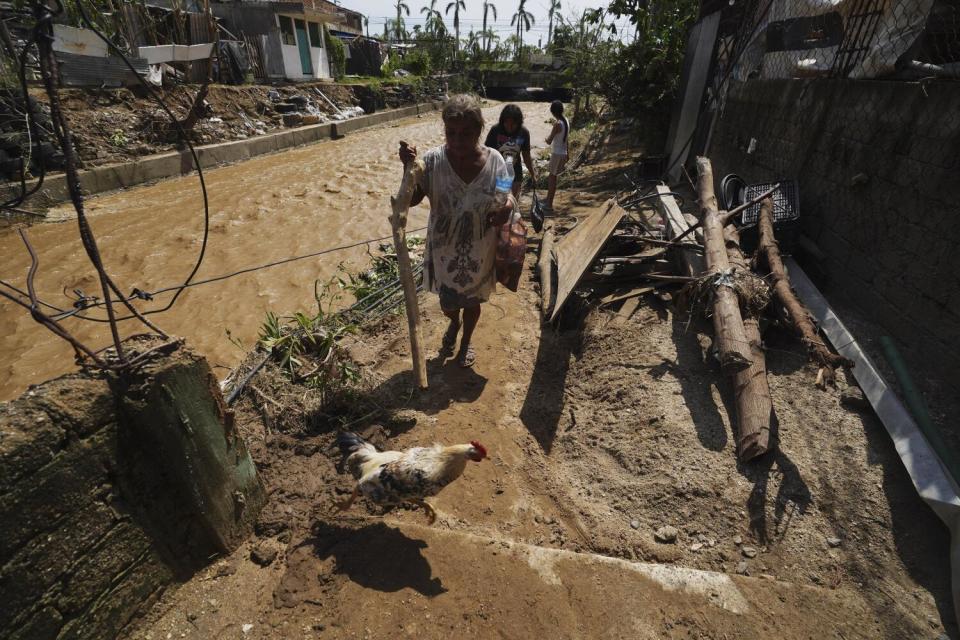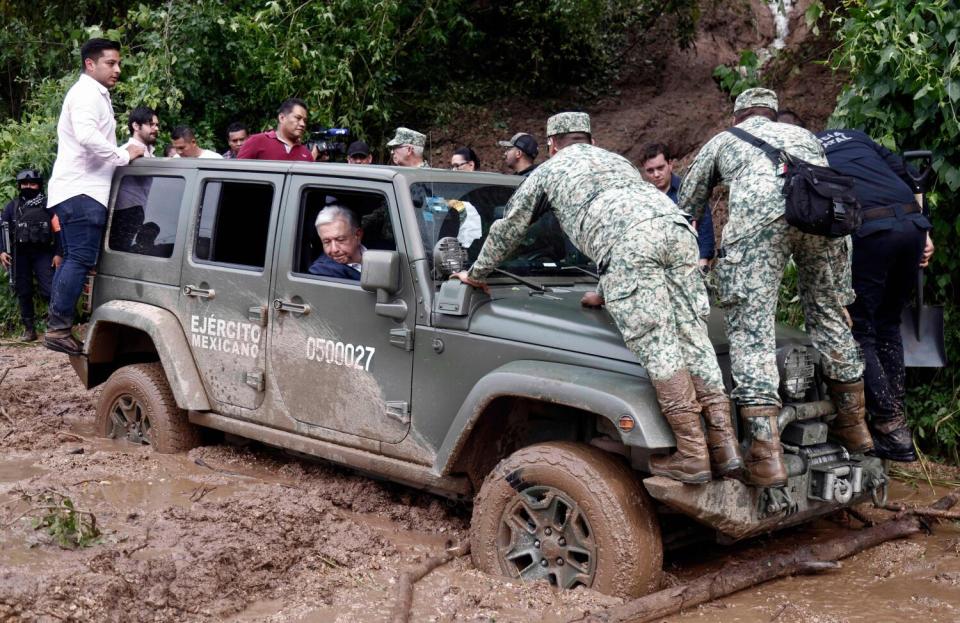Desperation after Acapulco hurricane: 'We no longer have food or water, and no one is helping us'

Two days after an extraordinarily powerful hurricane lashed Acapulco, causing widespread damage and at least 27 deaths, residents and tourists here were growing increasingly desperate.
On the highway approaching this beleaguered city, dozens of residents lined the road Friday with signs begging for aid.
"We're hungry," said one sign. "We need food," said another. "Please help us," said a third.
"No one has come. The government has done nothing," said Hisaele Saucedo Bernal, 58. She said her home had flooded up to her waist when Hurricane Otis slammed the coastline as a Category 5 storm early Wednesday morning, cutting a wide path of destruction.
"I am very hungry; we have not eaten," said Maria Luisa Tabares, 78. "We no longer have food or water, and no one is helping us."
A quarter-million homes remained without electricity, and food, gasoline and clean water were in short supply. With little aid distribution and few if any shopping establishments open for business, many in this city of nearly 1 million resorted to taking goods from shattered storefronts.
On streets blocked by downed power poles, mangled palms and other debris, others were jammed into storm-damaged vehicles and attempting to flee.

Read more: 'Two hours of hell:' At least 27 are dead in Mexico after Hurricane Otis pounds Acapulco
Government officials said thatmore than 13,000 federal troops had been deployed to the city and that 7,500 portions of food supplies had been distributed, along with 7,000 liters of water.
On Friday, officials said 40 tons of additional supplies would be delivered by plane to a recently reopened airport.
In parts of the city on Friday, soldiers were clearing roads and utility company employees were at work repairing downed power lines. But there were few signs of food or water distribution or medical care. And many on the ground said they were frustrated that the government appeared largely absent.
Read more: A stone, a bullet, a burial. A Palestinian boy's death in the West Bank signals wider unrest
"The president says there are people helping us here, but there's nobody," said one sobbing woman in a video widely circulated on social media Friday. “And there are many dead, many more than they say."
While the official death toll stood at 27, there was growing evidence that there may be additional casualties not yet accounted for.
At the city's once-elegant yacht club, hulking boats had been lifted from the waves and tossed ashore, and six bodies wrapped in fabric were lined up on a patch of grass.
Local journalists reported seeing bodies in other parts of town that probably also had not yet been counted, and a correspondent for National Public Radio wrote on X that the bodies of about 50 fishermen had been dragged from the sea.
There were also growing concerns that more people may have died in remote areas north of the city that are still largely without communication.

Speaking at his daily news conference Friday, President Andrés Manuel López Obrador said he believed Mexico had been "lucky" to have survived the hurricane with so few deaths.
"Everything indicates that ... there were not so many," he said. "Fortunately we are not registering many losses of human life."
He downplayed accounts of disorder and fear in the streets, saying the government was attending to residents and would continue to do so.
"We will not leave Acapulco until it’s reestablished and has returned to normal," said López Obrador.
He said that he thought the city could be rebuilt in "little time," and that government officials were meeting Friday with representatives of the hotel industry, who say 80% of hotels in the city were damaged by the storm.
The vast panorama of damage has stirred deep fears about Acapulco’s future.
Disaster modeler Enki Research predicts that the economic impact may top $15 billion, and some here worry that recovery of the coastal resort city, once favored by Hollywood stars but in recent years tarnished by drug violence, could drag on for years.
Despite its loss of international luster in recent years, Acapulco's economic engine had remained what is now a broken tourist industry.
Many residents came here for work from other parts of Guerrero state, which is among Mexico’s poorest and most violent states.
“Some people said things would be back to normal in two months, but — seeing the extent of the damage — it’s going to take a lot longer,” predicted Elizabeth Barreto, 40, who works as a restaurant cook in the stylish Caleta Beach district.
The coming Christmas season is already lost, she said. “Maybe next Christmas? Who knows?”
She was taking stock of the damage during a coastline walk with her two children, 16 and 11, and her husband, Pedro Juarez, who makes a living selling tickets for boat tours.
“Acapulco lives off tourism; it always has,“ said Juarez, 50, glancing at the coastal view of battered buildings and collapsed beach bars. “This is going to make life difficult for all of us for some time.”
While some have criticized the government for not doing more to warn residents about the hurricane, the president reiterated that the storm's ferocity took everyone — even weather experts — by surprise.

"Ask the hurricane centers if this wasn't an extraordinary phenomenon," he said.
Indeed, just 24 hours before the deluge, Otis was categorized as a tropical storm. But after hitting a patch of warm ocean water, it grew rapidly into what the U.S. National Hurricane Center warned would be a "potentially catastrophic Category 5 hurricane."
Scientists say it was the fastest-growing hurricane ever observed in the eastern Pacific Ocean. As oceans warm due to human-driven climate change, similarly super-charged hurricanes are likely to occur more frequently, they say.
In downtown Acapulco, stranded tourists wandered the streets in a daze.
Amalia Garrido, 63, was one of dozens of visitors camped out Thursday night near a closed gas station along Acapulco's famed coastal boulevard, Avenida Costera Miguel Alemán.
Once lined with sleek hotels, nightclubs and seafood restaurants, the road was nearly unrecognizable: strewn with glass, twisted metal and other debris. Hotels and high-rise condos were disfigured, their balconies sheared away as though a malevolent giant had clawed through the city.
"It makes you want to cry, because everything is so ugly, so destroyed," said Garrido, who had arrived in Acapulco on Monday with seven family members to celebrate her grandson's birthday.
Their hotel was severely damaged, and they and other guests had been forced out onto the streets. She and her relatives had no idea how to exit the city, and no clue where to sleep.
"The truth is that I am afraid," Garrido said. "There is no water here; there is no food."
José Castro, a 29-year-old graphic designer, had arrived in Acapulco on Monday and said he'd been swimming in the ocean just hours before the hurricane hit. He said he was shocked that the government hadn't done more to prepare those in danger as it became clear that the storm was strengthening.
"On Tuesday we were on the beach and there was no warning of danger," he said. "How is it possible that no authority warned us that there would be a hurricane?"
"Nobody has helped us," said Castro. "Really, this has been the worst experience of my life."
McDonnell reported from Acapulco and Linthicum from Mexico City. Special correspondent Cecilia Sanchez Vidal in Acapulco contributed to this report.
This story originally appeared in Los Angeles Times.


